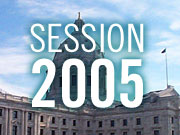January 26, 2005
 |
| University of Minnesota President Robert Bruininks says he's pleased with Gov. Pawlenty's budget proposal, which increases funding for higher education by 8.4 percent. (MPR Photo/Marisa Helms) |
St. Paul, Minn. — Gov. Tim Pawlenty says his proposal is a priority-based budget. For the University of Minnesota, that means funding key research activities in the amount of $113 million in new money, a 10 percent increase over the last budget cycle.
"There's a number of requests that they have made. We have fully funded almost all of them," said Pawlenty.
Pawlenty's recommendations include $36 million for the U's biosciences initiative, and another $50 million for faculty, student and researcher recruiting and retention. He also proposes $15 million be split between the U and the Mayo Foundation for its biotech and genomics partnership.
University of Minnesota President Bob Bruininks says he's pleased.
"I think this is a very strong recommendation. And the recommendations are strongly aligned with the priorities as we reflected them in our budget request," said Bruininks.
Bruininks says Pawlenty's proposal gives the university about 90 percent of what it asked for.
Overall, Pawlenty's proposal for higher education is up 8.4 percent over the last budget cycle.
But conspicuously absent in Pawlenty's recommendations are enrollment adjustments worth tens of millions of dollars. MnSCU officials say they're due the adjustments because they enrolled more students than the state had projected. Pawlenty thinks otherwise.
"We'll just put it this way. I think we have funded what was most important to them. And enrollment adjustments relates to costs incurred for students that they had two years ago," Pawlenty said.
Many in the MnSCU system are crying foul over that characterization.
Rochester Community and Technical college student Amy Bothun says Minnesota is statutorily required to adjust its appropriation according to enrollment.
"Since the '98-'99 academic year, enrollment has gone up 30,000. But funding allocated for MnSCU's enrollment numbers has stayed virtually the same," said Bothun. "So that's like me having 30,000 more children, and not increasing the income just to cover the needs of those extra children."
MnSCU's request to lawmakers includes $130 million in enrollment adjustment money. But the governor recommends $50 million, and wants it used to wean the system from enrollment-based budgeting. Pawlenty says funding should be linked to performance, efficiency, and productivity on MnSCU campuses.
Pawlenty is also putting money into other initiatives he wants MnSCU to pursue. They include $20 million to establish "centers of excellence," within the system, another $14 million for the system's growing online and distance learning programs, and $10 million for MnSCU's nursing program.
Last budget cycle, MnSCU and the University of Minnesota saw their budgets cut by 15 percent because of the state's multi-billion dollar deficit. As a result, the systems hiked tuition by double-digits for the fourth year in a row.
The two systems have pledged to keep tuition at single digits -- if the state fully funds their requests. The U's Bruininks says he's hopeful the final appropriation will allow tuition to stay low.
MnSCU Chancellor James McCormick isn't as optimistic. He says MnSCU students could be faced with increases larger than his proposed 4 percent.
"I know one thing, we're not going to have a deficit. So we're either going to have to raise revenue or make cuts, or a combination, and we'll face all that after the legislative session is over," said McCormick.
Sen. Sandy Pappas, DFL-St. Paul, who chairs the Senate Higher Education Committee, says she's happy Pawlenty is calling for an increase. But she says the systems should be compensated for serving more students.
Her counterpart in the House, Rep. Bud Nornes, R-Fergus Falls, says the governor's proposal is a good place to start in his committee's budget deliberations.





